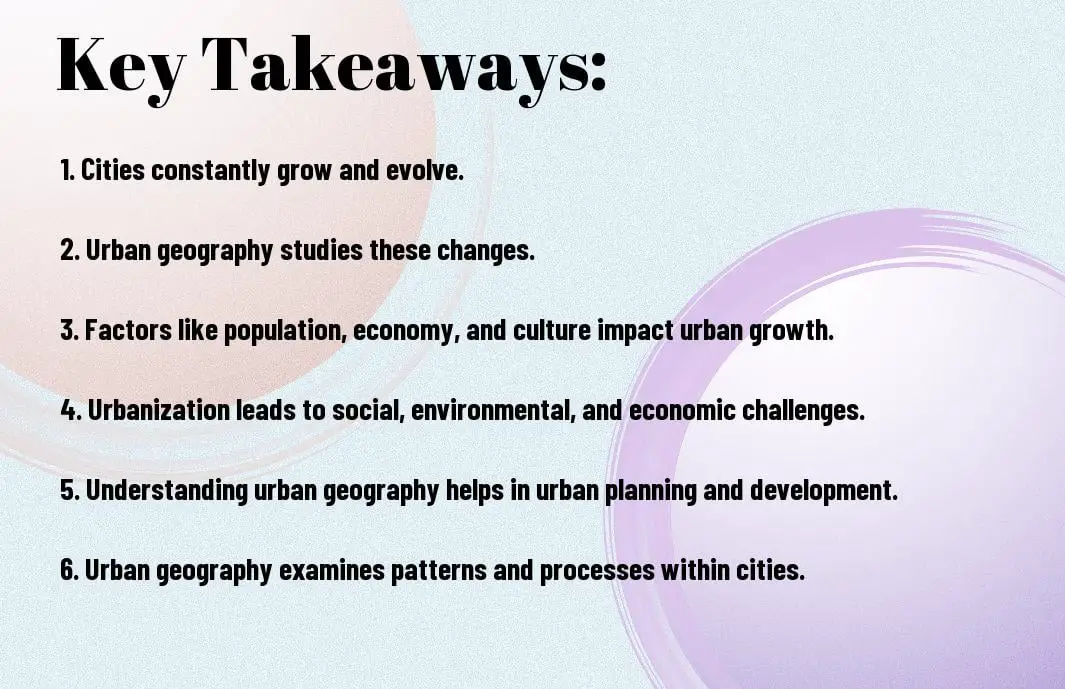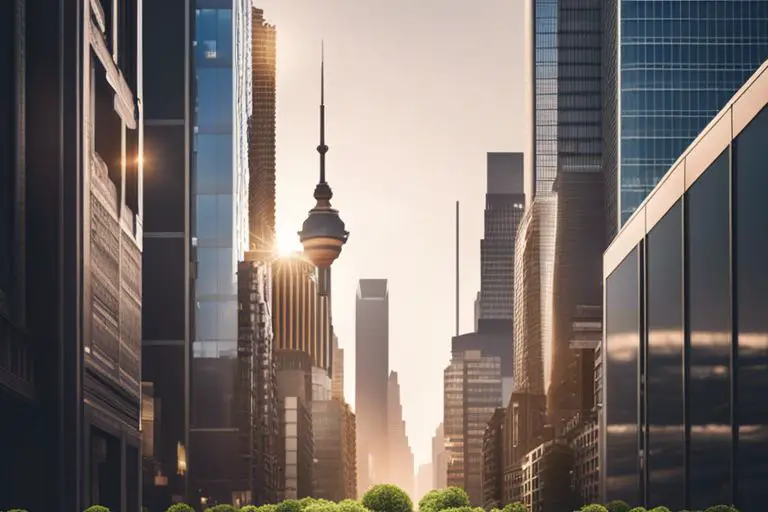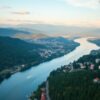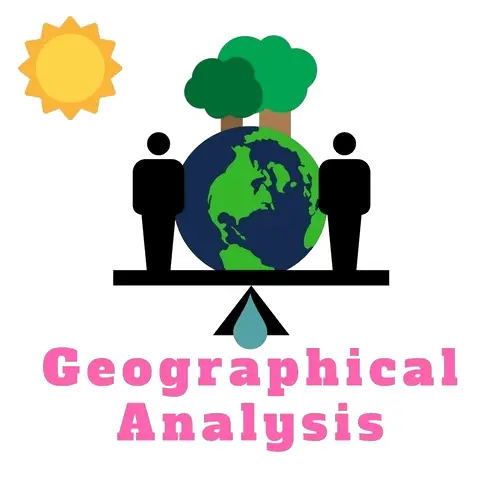Explore the fascinating world of urban geography as we delve into the complexities of how cities have grown and transformed over time. From the rise of megacities to the challenges of urban sprawl, this blog post will provide a comprehensive overview of the forces shaping the modern urban landscape. Gain insight into the critical issues surrounding urbanization and discover the remarkable ways in which cities are evolving to meet the needs of their inhabitants. Whether you’re a student of geography or simply intrigued by the dynamics of city life, this post will offer a valuable introduction to the dynamic field of urban geography.
Key Takeaways:
- Urbanization: The process of urbanization continues to shape the growth and transformation of cities, leading to increased population density and the development of urban infrastructure.
- Urban Land Use: Land use within cities is a complex and dynamic process, with competing demands for residential, commercial, and industrial space influencing the urban landscape.
- Social and Economic Impact: The growth and transformation of cities have significant social and economic impacts, affecting everything from housing affordability to transportation and employment opportunities.

Historical Development of Urban Spaces
Obviously, the historical development of urban spaces is a complex and fascinating subject. Throughout history, cities have played a crucial role in the development of human societies, serving as centers of commerce, culture, and political power.
Early Urbanization: From Agricultural Villages to Cities
Development of early urban spaces can be traced back to the transition from agricultural villages to cities. This transition was driven by the need for centralized systems of governance, trade, and defense. As agriculture became more efficient, surplus food production allowed for the establishment of permanent settlements, which eventually grew into urban centers.
Industrial Revolution and Urban Expansion
To understand the industrial revolution’s impact on urban spaces, it is essential to consider the profound social, economic, and technological changes that took place during this period. The advent of steam power, mass production, and advancements in transportation led to the rapid expansion of cities and the emergence of a new urban industrial landscape.
Industrial revolution brought significant social and environmental challenges, including overcrowding, pollution, and poor living conditions in rapidly growing urban areas.
Modern Urban Growth: Twenty-First Century Metropolises
Modern urban growth in the twenty-first century has been characterized by the rapid rise of megacities and the increasing interconnectedness of global urban spaces. The unprecedented pace of urbanization, driven by factors such as globalization, technological advancements, and rural-to-urban migration, has reshaped the urban landscape in profound ways.
With the rise of megacities, urban areas are facing new challenges and opportunities, including issues of sustainability, social inequality, and the need for innovative urban planning and design.
Urban Planning and Structure
After examining the growth and transformation of cities, it is clear that urban planning and structure play a crucial role in their development. Urban planning involves the design and organization of urban spaces, including the layout of infrastructure, transportation systems, and social and environmental considerations. The structure of a city encompasses its physical layout, including the arrangement of buildings, roads, and green spaces, as well as the distribution of residential, commercial, and industrial areas.
Theories and Models of Urban Design
One of the key components of urban planning and structure is the implementation of theories and models of urban design. These theories and models provide a framework for understanding how cities develop and how they can be organized and designed to best meet the needs of their residents. They help urban planners and designers make informed decisions about land use, transportation systems, and the allocation of resources within a city.
Transportation and Infrastructure in City Planning
Designing efficient and sustainable transportation systems and infrastructure is a critical aspect of city planning. Effective transportation systems can reduce traffic congestion, improve air quality, and provide better access to jobs, education, and healthcare. The layout and design of infrastructure such as roads, public transit, and utilities have a significant impact on the overall structure and function of a city.
Planning transportation and infrastructure in city planning involves considering factors such as population density, economic development, and environmental impact. It requires careful consideration of how people and goods move within and between urban areas, as well as the maintenance and expansion of essential services and utilities. By prioritizing sustainable and inclusive transportation and infrastructure, cities can create healthier and more equitable living environments for their residents.
Social and Environmental Considerations in Urban Development
Social and environmental considerations are integral to urban development, as they directly affect the quality of life for city residents and the long-term sustainability of urban areas. Social factors such as access to affordable housing, public spaces, and community resources can significantly impact the well-being and cohesion of urban populations. Environmental factors, including air and water quality, green spaces, and climate resilience, are essential for creating healthy and resilient cities.
Urban planners and designers must consider social and environmental considerations in urban development to create livable and sustainable cities. By integrating these considerations into urban planning and design, cities can foster inclusive communities, promote environmental justice, and build resilient urban ecosystems for future generations.
Socioeconomic Aspects of Urban Life
Not only do cities serve as important hubs of economic and social activity, but they also play a critical role in shaping the overall socioeconomic landscape of a country. The interaction between demographic changes, economic transformations, and urban culture significantly influences the fabric of urban life. Examining these aspects offers insights into the challenges and opportunities associated with urbanization.
Demographic Changes and Migration Patterns
Life in urban areas is characterized by dynamic demographic changes and intricate migration patterns. Cities often experience significant population growth due to migration from rural areas and other countries, leading to diverse and vibrant communities. Understanding these demographic shifts is crucial for policymakers and urban planners as they strive to address the needs of a rapidly changing population. For further reading, you can refer to Cities and Green Growth: A Conceptual Framework.
Economic Transformations and the Role of Industry
The economic landscape of urban areas undergoes constant transformation, with the role of traditional industries evolving alongside the emergence of new economic sectors. The interplay between technological advancements, globalization, and shifting consumer preferences shapes the economic dynamics of cities. The ability of urban areas to adapt to these changes determines their long-term sustainability and resilience. To delve deeper into this topic, consider the impact of industrial development on urban spaces and livelihoods.
To analyze urban economic transformations and their impact on local communities, consider the keywords such as industrial development, technological advancements, and globalization.
Urban Culture: Diversity, Creativity, and Conflict
Creativity thrives in urban settings, fueled by the diversity of culture, ideas, and experiences that converge within city boundaries. However, this diversity can also lead to conflicts and social tensions as different groups navigate urban spaces. Recognizing and celebrating the richness of urban culture while addressing the challenges it presents is essential for fostering inclusive and harmonious communities.
Patterns in urban culture can encompass a wide range of themes, including diversity, creativity, and conflict, offering valuable insights into the societal dynamics of cities.
Understanding the complex socioeconomic aspects of urban life is crucial for policymakers and city planners as they seek to address the challenges and opportunities presented by urbanization. The interplay between demographic changes, economic transformations, and urban culture shapes the fabric of urban life, with far-reaching implications for societal well-being. By examining these aspects, stakeholders can develop informed strategies to create sustainable, inclusive, and thriving urban communities.
Challenges and Opportunities in Urban Areas
For many urban areas, one of the biggest challenges is managing overpopulation and urban sprawl. As cities grow, they face increasing pressure on their infrastructure, housing, and resources. Overpopulation leads to congestion, pollution, and increased demand for services, while urban sprawl can lead to inefficient land use and reduced access to essential services for some communities.
Managing Overpopulation and Urban Sprawl
For cities looking to manage overpopulation and urban sprawl, there are a variety of strategies that can be implemented. These include urban planning and design that prioritize efficient land use and public transportation, as well as smart growth policies that encourage compact, walkable urban development.
Sustainable Development and Smart Cities
Managing sustainable development and fostering the creation of smart cities is crucial for the long-term viability of urban areas. This involves integrating technology and data to improve efficiency and resource management, as well as adopting green infrastructure and sustainable building practices.
This approach seeks to minimize environmental impact and promote equitable access to resources and opportunities for all residents. It also seeks to maximize efficiency and reduce waste in urban areas, creating a more livable and sustainable environment for all.
Policy Responses to Urban Issues and the Future of Urban Living
Opportunities for policy responses to urban issues are essential for shaping the future of urban living. Investment in affordable housing, sustainable infrastructure, and public amenities can help improve the quality of life for urban residents and reduce disparities within cities.
Areas for policy responses also involve innovation and collaboration between public and private sectors to address urban challenges. By encouraging creativity and flexibility in policy making, cities can adapt to changing needs and promote inclusive and sustainable urban development.
Conclusion
So, urban geography provides invaluable insight into the complex processes of growth and transformation within cities. By examining the factors influencing urban development, we can better understand the challenges and opportunities facing these dynamic environments. As cities continue to evolve in response to economic, social, and environmental forces, it is essential to stay informed about the latest trends and patterns shaping our urban landscapes. With a solid grasp of urban geography principles, we can contribute to the sustainable and equitable development of cities around the world.
Urban Geography 101 – Examining The Growth And Transformation Of Cities
Q: What is urban geography?
A: Urban geography is the study of the physical, social, economic, and political aspects of cities and urban areas. It focuses on the spatial organization and distribution of cities, as well as the processes that shape urban environments and landscapes.
Q: What factors contribute to the growth of cities?
A: The growth of cities is influenced by a variety of factors, including population growth, migration, industrialization, and economic development. As cities offer a wide range of job opportunities, better access to amenities, and a higher standard of living, people are drawn to urban areas, leading to their expansion and growth.
Q: How do cities transform over time?
A: Cities undergo transformation through various processes such as urbanization, suburbanization, gentrification, and urban renewal. These processes reshape the physical and social landscapes of cities, leading to changes in population distribution, land use, infrastructure, and cultural dynamics. Urban geography examines these transformations and their impacts on the urban environment.







